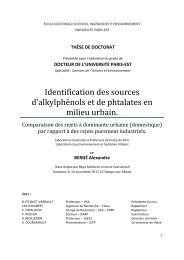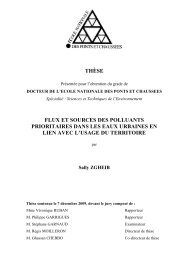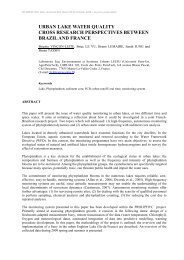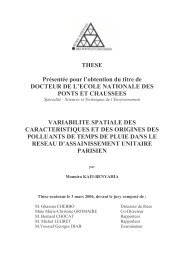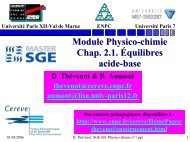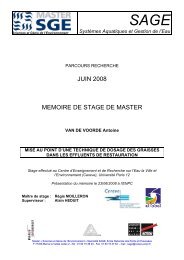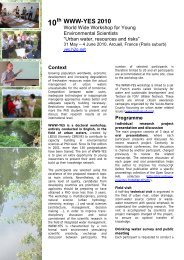View - ResearchGate
View - ResearchGate
View - ResearchGate
You also want an ePaper? Increase the reach of your titles
YUMPU automatically turns print PDFs into web optimized ePapers that Google loves.
seeks to uncover a deeper meaning of the phenomenon of social learning. This study does notrely on measurable variables, but adopts a more open-ended approach, allowing ‘truth’ to emergethrough use of in-depth interviews and the analysis of personal experiences through narrative.The method underpinning this research is known as ‘enthusiasm’. The ‘enthusiasm’ method is anapproach to case study research and involves listening to people, especially to their stories of thepast and present, and provides them with the opportunity to voice their hopes and wishes for thefuture. As such, it involves creating opportunities for dialogue from which learning and personal,social and/or environmental change may result. Whilst relatively uncommon, the enthusiasmmethod has been successfully used and championed by researchers such as Ray Ison; forexample during participative rural development projects in New South Wales (Ison & Russell2000).The ‘enthusiasm’ method is underpinned by the biological and theoretical understanding of theenthusiasm ‘drive’ itself. The key to using enthusiasm as a research method is that theresearcher does not re-direct a participant’s energy – rather it is the researcher’s initial task todiscover where a participant’s energy lies. Ison suggests that this can be done by asking the‘right’ sorts of questions. Some of these questions could include ‘what do you want to do…?’ or‘why are you involved with…?’ or ‘what is it you get out of this activity that you findsatisfying?’. Ison recommends that engaging participants with this sort of conversation requiresrespect for the individuality of participants and acceptance that whatever they are going to say isvalid. This, he suggests, is based on the notion that it is the god within a person that has to berespected. In giving the participants the opportunity to be actively listened to they will have theopportunity to tell the story of where their energy comes from, how they see it expressing itselfand what they consider as obstacles to the manifestation of their energy. Underpinning all this isthe ethical implication that research participants’ have ‘control of the process (Ison & Russell2000).The following features foster the use of enthusiasm as a research method: Active listening and cultivation of stories; Space for facilitated participation; Avoidance of imposed practices that enforce consensus; Collective responsibility, transparency, and rituals which create a sense of commonpurpose.A case study is being used to inform this inquiry as it gives the researcher great opportunity forinsight, analysis and interpretation (Merriem 1988). Three key research techniques are being usedto collect rich, meaningful data in the case study. In-depth, unstructured interviews with openended questions are being undertaken with approximately thirty stakeholders of the Pennyroyaland Deans Marsh Creek restoration project. These interviews allow the research participants toexplore and explain their experience with the social learning process; and give the researcher theopportunity to understand the interviewees’ experiences with the phenomenon of social learningand the phenomenon itself. Facilitation of the learning process in workshop settings engagesresearch participants with opportunities for social learning. Observation of the social learningprocess allows the allows the researcher to reflect upon and make sense of the process of sociallearning through first hand experience and allows the researcher to judge whether a sociallearning approach is an effective complementary management tool for catchment management.Relatively informal data gathering techniques are also being used. For example, casualconversations and incidental observations also provide a rich source of information to validate orprovide a different perspective from interview responses and set the context of the study. Datacollected in this way is building a picture of the role that social learning plays in contributing tothe restoration of the Pennyroyal and Deans Marsh Creek.The case study is being undertaken in six clear stages. Table 2 below outlines the events of eachstage, the data collection and analysis techniques and how the data is being validated.Table 2: Case study stagesStage What happens Data Collection/Data Analysis1 Engage the CCMA to establish an‘invitation’ to conduct the study in theirregion. Establish a relationship of mutualinterest/benefit; to prevent the feeling ofbeing invaded or exploited by theresearcher; and to prevent powerimbalances.2 Conduct a systems analysis and construct asystems map of the Corangamitecatchment region to identify the majorwater stakeholders; projects beingundertaken; and perceived problems in thecatchment region.3 Conduct an historical analysis of theCCMAs’ practices to determine whethersocial learning is being used to engagestakeholders in decision making processesfor water management, i.e. do they alreadyuse social learning without knowing it?4 Identify social learning already occurring inthe Pennyroyal and Deans Marsh Creeksrestoration project.:Participant observation(becoming an insider)InterviewsSystems AnalysisDocument analysisInterviewsDocument and dataanalysisInterviewsFacilitation of learningprocessParticipant observation What sort of social learning isoccurring? Who is facilitating? Who is learning?In-depthinterviews What impact is social learning having,unstructuredi.e. changes in social capital, ecologicalcapital, or learning processes?5 Identify co-researchers within the CCMA; Participant observationtest the SLIM framework to analyse sociallearning processes in the Pennyroyal andDeans March Creeks Restoration Project.6 Develop a locally-contextual social learning Thematic analysismodel for catchment management inVictoria.CONCLUSIONValidity/EthicsFace validityTriangulationFace validityTriangulationFace validityTriangulationFace validityThere is increasing concern associated with water security in Australia. While AustralianFederal and State government’s have implemented several new strategies that address watermanagement, using market driven, regulatory, educational and incentive based approaches, nonehave adequately provided for true participatory and integrative approaches. The need to fill thisWWW-YES 2008, Paris 13 – 16 May 2008 63WWW-YES 2008, Paris 13 – 16 May 2008 64



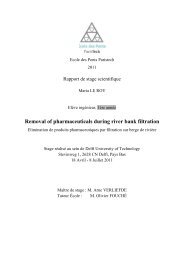
![[pastel-00730831, v1] Incidence des pratiques d'entretien ... - LEESU](https://img.yumpu.com/50938896/1/184x260/pastel-00730831-v1-incidence-des-pratiques-dentretien-leesu.jpg?quality=85)

